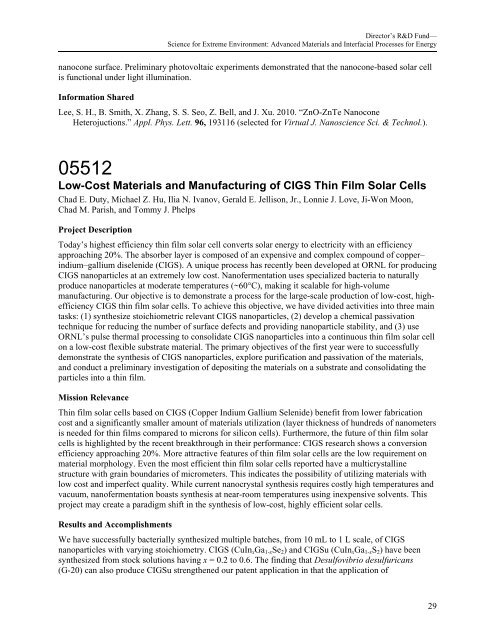FY2010 - Oak Ridge National Laboratory
FY2010 - Oak Ridge National Laboratory
FY2010 - Oak Ridge National Laboratory
Create successful ePaper yourself
Turn your PDF publications into a flip-book with our unique Google optimized e-Paper software.
Director’s R&D Fund—<br />
Science for Extreme Environment: Advanced Materials and Interfacial Processes for Energy<br />
nanocone surface. Preliminary photovoltaic experiments demonstrated that the nanocone-based solar cell<br />
is functional under light illumination.<br />
Information Shared<br />
Lee, S. H., B. Smith, X. Zhang, S. S. Seo, Z. Bell, and J. Xu. 2010. “ZnO-ZnTe Nanocone<br />
Heterojuctions.” Appl. Phys. Lett. 96, 193116 (selected for Virtual J. Nanoscience Sci. & Technol.).<br />
05512<br />
Low-Cost Materials and Manufacturing of CIGS Thin Film Solar Cells<br />
Chad E. Duty, Michael Z. Hu, Ilia N. Ivanov, Gerald E. Jellison, Jr., Lonnie J. Love, Ji-Won Moon,<br />
Chad M. Parish, and Tommy J. Phelps<br />
Project Description<br />
Today’s highest efficiency thin film solar cell converts solar energy to electricity with an efficiency<br />
approaching 20%. The absorber layer is composed of an expensive and complex compound of copper–<br />
indium–gallium diselenide (CIGS). A unique process has recently been developed at ORNL for producing<br />
CIGS nanoparticles at an extremely low cost. Nanofermentation uses specialized bacteria to naturally<br />
produce nanoparticles at moderate temperatures (~60°C), making it scalable for high-volume<br />
manufacturing. Our objective is to demonstrate a process for the large-scale production of low-cost, highefficiency<br />
CIGS thin film solar cells. To achieve this objective, we have divided activities into three main<br />
tasks: (1) synthesize stoichiometric relevant CIGS nanoparticles, (2) develop a chemical passivation<br />
technique for reducing the number of surface defects and providing nanoparticle stability, and (3) use<br />
ORNL’s pulse thermal processing to consolidate CIGS nanoparticles into a continuous thin film solar cell<br />
on a low-cost flexible substrate material. The primary objectives of the first year were to successfully<br />
demonstrate the synthesis of CIGS nanoparticles, explore purification and passivation of the materials,<br />
and conduct a preliminary investigation of depositing the materials on a substrate and consolidating the<br />
particles into a thin film.<br />
Mission Relevance<br />
Thin film solar cells based on CIGS (Copper Indium Gallium Selenide) benefit from lower fabrication<br />
cost and a significantly smaller amount of materials utilization (layer thickness of hundreds of nanometers<br />
is needed for thin films compared to microns for silicon cells). Furthermore, the future of thin film solar<br />
cells is highlighted by the recent breakthrough in their performance: CIGS research shows a conversion<br />
efficiency approaching 20%. More attractive features of thin film solar cells are the low requirement on<br />
material morphology. Even the most efficient thin film solar cells reported have a multicrystalline<br />
structure with grain boundaries of micrometers. This indicates the possibility of utilizing materials with<br />
low cost and imperfect quality. While current nanocrystal synthesis requires costly high temperatures and<br />
vacuum, nanofermentation boasts synthesis at near-room temperatures using inexpensive solvents. This<br />
project may create a paradigm shift in the synthesis of low-cost, highly efficient solar cells.<br />
Results and Accomplishments<br />
We have successfully bacterially synthesized multiple batches, from 10 mL to 1 L scale, of CIGS<br />
nanoparticles with varying stoichiometry. CIGS (CuIn x Ga 1-x Se 2 ) and CIGSu (CuIn x Ga 1-x S 2 ) have been<br />
synthesized from stock solutions having x = 0.2 to 0.6. The finding that Desulfovibrio desulfuricans<br />
(G-20) can also produce CIGSu strengthened our patent application in that the application of<br />
29
















